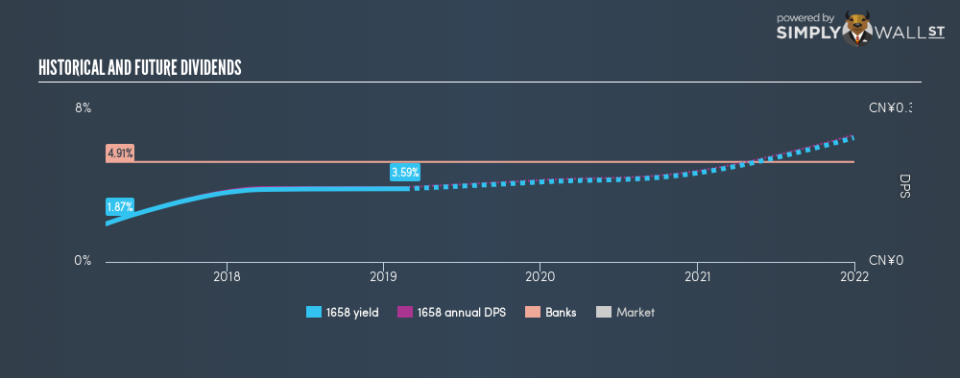Is Postal Savings Bank of China Co., Ltd. (HKG:1658) A Great Dividend Stock?

Want to participate in a short research study? Help shape the future of investing tools and receive a $20 prize!
A sizeable part of portfolio returns can be produced by dividend stocks due to their contribution to compounding returns in the long run. Postal Savings Bank of China Co., Ltd. (HKG:1658) has paid a dividend to shareholders in the last few years. It currently yields 3.6%. Let’s dig deeper into whether Postal Savings Bank of China should have a place in your portfolio.
Check out our latest analysis for Postal Savings Bank of China
5 questions I ask before picking a dividend stock
If you are a dividend investor, you should always assess these five key metrics:
Is it paying an annual yield above 75% of dividend payers?
Has its dividend been stable over the past (i.e. no missed payments or significant payout cuts)?
Has the amount of dividend per share grown over the past?
Is its earnings sufficient to payout dividend at the current rate?
Based on future earnings growth, will it be able to continue to payout dividend at the current rate?
How does Postal Savings Bank of China fare?
The company currently pays out 23% of its earnings as a dividend, according to its trailing twelve-month data, which means that the dividend is covered by earnings. Going forward, analysts expect 1658’s payout to remain around the same level at 25% of its earnings. Assuming a constant share price, this equates to a dividend yield of 4.2%. Furthermore, EPS should increase to CN¥0.71.
If you want to dive deeper into the sustainability of a certain payout ratio, you may wish to consider the cash flow of the business. Cash flow is important because companies with strong cash flow can usually sustain higher payout ratios.
If dividend is a key criteria in your investment consideration, then you need to make sure the dividend stock you’re eyeing out is reliable in its payments. Unfortunately, it is really too early to view Postal Savings Bank of China as a dividend investment. It has only been consistently paying dividends for 2 years, however, standard practice for reliable payers is to look for a 10-year minimum track record.
In terms of its peers, Postal Savings Bank of China has a yield of 3.6%, which is on the low-side for Banks stocks.
Next Steps:
If Postal Savings Bank of China is in your portfolio for cash-generating reasons, there may be better alternatives out there. However, if you are not strictly just a dividend investor, the stock could still offer some interesting investment opportunities. Given that this is purely a dividend analysis, you should always research extensively before deciding whether or not a stock is an appropriate investment for you. I always recommend analysing the company’s fundamentals and underlying business before making an investment decision. I’ve put together three fundamental aspects you should look at:
Future Outlook: What are well-informed industry analysts predicting for 1658’s future growth? Take a look at our free research report of analyst consensus for 1658’s outlook.
Valuation: What is 1658 worth today? Even if the stock is a cash cow, it’s not worth an infinite price. The intrinsic value infographic in our free research report helps visualize whether 1658 is currently mispriced by the market.
Dividend Rockstars: Are there better dividend payers with stronger fundamentals out there? Check out our free list of these great stocks here.
We aim to bring you long-term focused research analysis driven by fundamental data. Note that our analysis may not factor in the latest price-sensitive company announcements or qualitative material.
If you spot an error that warrants correction, please contact the editor at editorial-team@simplywallst.com. This article by Simply Wall St is general in nature. It does not constitute a recommendation to buy or sell any stock, and does not take account of your objectives, or your financial situation. Simply Wall St has no position in the stocks mentioned. Thank you for reading.

